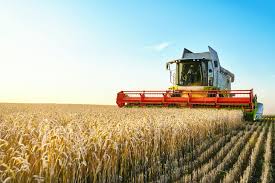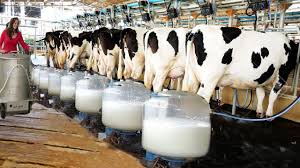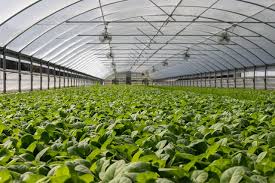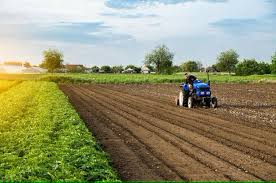Commercial farming is an advanced form of agriculture that focuses on producing large quantities of crops or livestock for sale in markets rather than for personal consumption.
Unlike subsistence farming, which is geared toward feeding a family or community, commercial farming is profit-driven and often involves modern techniques, equipment, and technology. Commercial farming plays a significant role in the global economy by supplying food and raw materials for industries, creating jobs, and contributing to trade.
This type of farming is essential in meeting the increasing demand for food, especially with growing populations and the expanding food industry.
Key Characteristics of Commercial Farming
Commercial farming has several defining features that distinguish it from other types of agriculture:
1. Large-Scale Production: Commercial farming typically involves large tracts of land where crops are grown, or livestock is raised on a large scale. The goal is to maximize yield and profitability.
2. Use of Modern Technology: Commercial farmers use advanced technology, such as tractors, harvesters, irrigation systems, and chemical inputs (fertilizers and pesticides) to improve efficiency and output.
3. Specialized Farming: Commercial farms often focus on producing one type of crop or livestock. Specialization allows farmers to streamline operations and improve productivity.
4. Market-Oriented Production: The primary goal of commercial farming is to produce for sale in the market. This type of farming is highly dependent on market demand, with farmers adjusting their production to meet consumer needs.
5. Investment and Capital-Intensive: Commercial farming requires significant financial investment in machinery, labor, seeds, fertilizers, and other inputs. It is capital-intensive and often requires access to credit or loans.
Arable Farming

Arable farming refers to the cultivation of crops on land specifically prepared for planting. This type of farming focuses on growing crops such as grains, vegetables, and fruits for sale. Arable farming can be conducted on large fields, with farmers using crop rotation and other techniques to maintain soil fertility and reduce the risk of pests and diseases.
1. Crops Grown: Common crops in arable farming include wheat, maize, rice, barley, potatoes, and various fruits and vegetables.
2. Technology and Inputs: Arable farming involves mechanized plowing, planting, irrigation, and harvesting, as well as the use of fertilizers and pesticides to enhance yields.
3. Market Focus: Crops grown in arable farming are typically sold to local or international markets, food processing industries, or directly to consumers.
Livestock Farming
Livestock farming, also known as animal husbandry, involves raising animals for food, fiber, and other products. Livestock farming can be highly specialized, focusing on a specific type of animal, such as cattle, sheep, pigs, or poultry. The animals are raised for meat, milk, wool, or eggs, with the products sold for profit.
1. Animals Raised: Common livestock include cattle, sheep, goats, pigs, chickens, and ducks.
2. Production Focus: The focus in livestock farming is to ensure healthy growth of animals for maximum output, whether it’s meat, milk, eggs, or wool.
3. Technology and Care: Modern livestock farms use advanced equipment for feeding, milking, and housing animals, as well as veterinary services to ensure animal health.
4. Market Focus: Products from livestock farming are sold to meat processors, dairy producers, wool industries, and other commercial markets.
Mixed Farming
Mixed farming involves the combination of crop cultivation and livestock farming on the same land. This method allows for diversification, reducing the risks associated with market fluctuations or crop failure.
In mixed farming, the livestock can benefit from crop residues, and animal manure can be used to fertilize the soil for crops, creating a more sustainable system.
1. Combination of Practices: Farmers grow crops and raise animals simultaneously, which provides multiple sources of income.
2. Advantages: Mixed farming reduces dependence on one type of production, improves soil health through manure use, and offers better risk management for farmers.
3. Market Focus: Both crops and livestock products are sold in local and global markets, making this farming system versatile.
Read Also: 15 Medicinal Health Benefits Of Cranesbill (Geranium)
Dairy Farming

Dairy farming focuses on raising cows, goats, or sheep for milk production. Dairy farms produce milk, which is either sold directly to consumers or processed into products like cheese, butter, yogurt, and cream. This type of farming requires intensive care and specialized facilities for milking and maintaining the health of dairy animals.
1. Animals Used: Common dairy animals include cows (most popular), goats, and sheep.
2. Technology and Inputs: Dairy farms often use milking machines, automated feeding systems, and veterinary care to maintain the health and productivity of the animals.
3. Production Focus: The primary focus is on maximizing milk production while ensuring the health and well-being of the animals.
4. Market Focus: Dairy products are sold to processors, supermarkets, and directly to consumers, often making their way into domestic and international markets.
Poultry Farming
Poultry farming involves raising domesticated birds such as chickens, turkeys, ducks, and geese primarily for their eggs, meat, or feathers. It is one of the most common and profitable forms of commercial farming due to the high demand for poultry products worldwide.
Poultry farming can range from small-scale operations to large industrial farms, providing essential protein sources for local and global markets.
1. Birds Raised: Chickens (broilers for meat and layers for eggs), turkeys, ducks, and geese.
2. Production Focus: Poultry farms are specialized in either meat production (broilers) or egg production (layers).
3. Technology and Inputs: Automated feeding systems, climate-controlled housing, and veterinary care are commonly used to enhance efficiency and ensure the health of the birds.
4. Market Focus: Poultry products, such as meat and eggs, are sold to processors, retailers, and consumers both locally and globally.
Aquaculture
Aquaculture, also known as fish farming, involves the controlled cultivation of fish, shellfish, and aquatic plants. It is a growing industry that plays a crucial role in meeting the increasing global demand for seafood.
Aquaculture can take place in freshwater or saltwater environments, including ponds, tanks, or ocean enclosures.
1. Common Species Raised: Fish (tilapia, salmon, catfish), shellfish (shrimp, oysters), and aquatic plants.
2. Technology and Inputs: Aquaculture farms use water quality monitoring systems, automatic feeders, and filtration systems to create optimal growing conditions.
3. Production Focus: The primary goal is to produce seafood for human consumption while maintaining the sustainability of aquatic resources.
4. Market Focus: Aquaculture products are sold to seafood processors, restaurants, and grocery stores.
Horticulture
Horticulture refers to the cultivation of fruits, vegetables, flowers, and ornamental plants. It is a highly specialized form of commercial farming that focuses on producing high-value crops. Horticulture plays a vital role in providing fresh produce and decorative plants for markets and homes.
1. Crops Grown: Fruits (apples, oranges, berries), vegetables (tomatoes, carrots, lettuce), flowers, and ornamental plants.
2. Technology and Inputs: Greenhouses, drip irrigation, and advanced soil management practices are commonly used to ensure the quality and productivity of crops.
3. Production Focus: Horticulture aims to maximize the quality and yield of high-value crops, often focusing on year-round production in controlled environments.
4. Market Focus: Horticultural products are sold to supermarkets, farmers’ markets, florists, and nurseries.
Read Also: 15 Medicinal Health Benefits Of Gentian (Gentiana)
Plantation Farming

Plantation farming is a large-scale form of commercial agriculture that focuses on the cultivation of cash crops, often in tropical regions.
These farms typically grow a single crop over vast areas of land, aiming to produce goods for export to international markets. Plantation farming is capital-intensive and often involves crops that require specific climate conditions.
1. Common Crops Grown: Coffee, tea, rubber, sugarcane, palm oil, cotton, and cocoa.
2. Technology and Inputs: Plantation farming involves mechanized harvesting, irrigation systems, and the use of fertilizers and pesticides to maintain high productivity.
3. Production Focus: The focus is on maximizing the yield of cash crops for export, which plays a significant role in the economies of many tropical countries.
4. Market Focus: Plantation crops are sold to global markets, often contributing significantly to national export revenues.
Benefits of Commercial Farming
1. Increased Food Production: Commercial farming allows for large-scale production of crops and livestock, helping meet the food demands of growing populations.
2. Economic Growth: Commercial farming contributes to national economies by creating jobs, generating income, and boosting trade.
3. Technological Advancements: The use of modern technology in commercial farming, such as mechanized equipment, irrigation systems, and biotechnology, increases productivity and efficiency.
4. Export Opportunities: Countries engaged in commercial farming can benefit from exporting agricultural products, enhancing trade balance and boosting GDP.
5. Job Creation: Commercial farming generates employment in various sectors, including farming, processing, transportation, and retailing.
6. Improved Food Quality: Through advancements in technology and farming practices, commercial farming helps improve the quality and consistency of food products.
Challenges in Commercial Farming
1. High Initial Investment: Commercial farming requires substantial financial investment in land, machinery, infrastructure, seeds, and fertilizers, making it difficult for small-scale farmers to enter the industry.
2. Environmental Impact: Large-scale farming practices can lead to deforestation, soil degradation, water depletion, and pollution from pesticides and fertilizers.
3. Market Volatility: Farmers are often vulnerable to fluctuations in market prices, which can affect their income and profitability.
4. Dependence on Chemicals: Commercial farming often relies heavily on chemical inputs, such as synthetic fertilizers and pesticides, which can harm the environment and pose health risks.
5. Water Usage: Intensive irrigation in commercial farming can lead to overuse of water resources, contributing to water scarcity in some regions.
6. Climate Change Vulnerability: Commercial farmers face challenges from extreme weather events, such as droughts, floods, and storms, which can affect crop yields and livestock health.
Commercial farming plays a critical role in meeting the world’s food needs and driving economic growth.
However, it also presents significant challenges, including environmental impacts and financial barriers, that must be managed for sustainable agricultural development.
Do you have any questions, suggestions, or contributions? If so, please feel free to use the comment box below to share your thoughts. We also encourage you to kindly share this information with others who might benefit from it. Since we can’t reach everyone at once, we truly appreciate your help in spreading the word. Thank you so much for your support and for sharing!
Read Also: Complete Composting Guide for Beginners






